Table of Contents
Definition of Lower Cross Syndrome
On average, Americans are sitting an average of 13 hours a day. Between commuting to and from work, the modern desk job lifestyle, sitting while eating and even sitting during a netflix binge, we seem to be on our butts ALOT. The effects of this lifestyle over time can lead to muscular imbalances around the pelvis which can take a toll on our lower back, discs, ligaments and tendons. The resultant series, or “cross”, of muscular imbalances has been termed lower cross syndrome.
Lower Cross Syndrome, otherwise known as Unterkreuz syndrome, distal cross syndrome, or pelvic cross syndrome is defined as a combination of muscular imbalances centered around the lower segment and pelvis. The combination of lengthening and shortening imbalances result in anterior tilting of the pelvis, hyperlordosis of the lumbar spine and increased flexion of the hips. Individuals with lower cross syndrome may also notice compensatory imbalances such as thoracolumbar hyperkyphosis and flexion at the knee.
Anatomy of Muscular Imbalance
In lower cross syndrome, there are key areas of the anatomy that are underactive or lengthened paired with areas that are overactive or shortened. These areas form what can be visualized as a diagonal cross from the dorsal side of the body to the ventral side. The shortened muscles of lower cross syndrome are the hip flexors and lumbar extensors while the lengthened muscles are the gluteus maximus and the deep abdominals. Figure 1 illustrates the Lower Cross Syndrome and relevant anatomy.
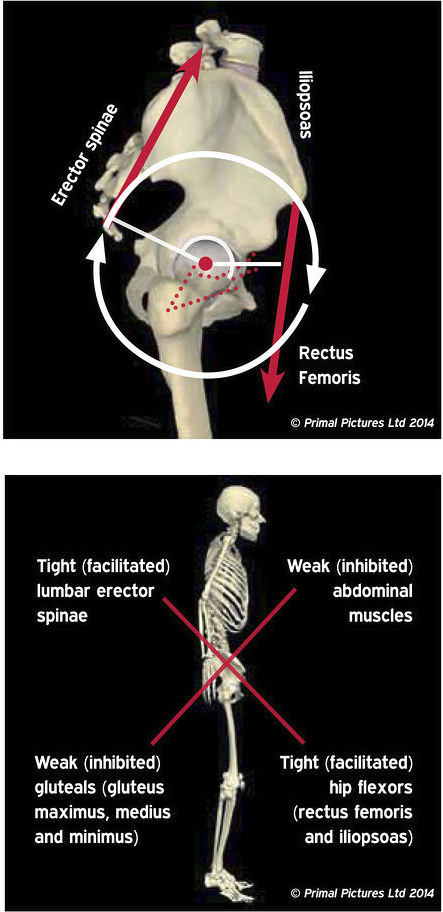
Relevant Anatomical Imbalances
- Under active and lengthened musculature
- Rectus abdominis
- Gluteus maximus
- Obliques internus abdominis
- Overactive and shortened musculature
Clinical Presentation
The muscular imbalances of lower cross syndrome create excessive ligamentous strain and pressure most commonly at the L4-S1 spinal segments as well as the sacroiliac joints and the hip joints. As noted above, individuals with lower cross syndrome will present with hyperlordosis of the lumbar spine, anterior pelvic tilt and the illusion of a protruded gluteal region. These individuals may also present with compensatory postural deviations such as increased thoracic kyphosis and cervical lordosis.
Diagnoses
Examination and diagnosis of lower cross syndrome begins with observation of the individuals stance and gait. Begin with observation of anterior pelvic tilt and hyperlordosis. Next, palpate and make note of the tone of the overactive and underactive musculature noted above. Note tension within the hamstrings, spinal erectors and hip flexors as well as hypotonicity within the deep abdominals and gluteal region.
Active and passive range of motion should be examined as well. An individual with lower cross syndrome will typically lack full range of motion of the hip extension because tension of the hip flexors will limit extension. You can test this by performing the Thomas test. Tight hamstrings will limits the ability to perform a full straight leg raise.
Often times individuals with lower cross syndrome will find it difficult to activate the gluteal musculature. It may be beneficial to test the individuals glutes by asking them to perform a clam shell, squat, or an exercise such as a monster walk to note the level of gluteal engagement.
Exercise Assessment to Aid Diagnosis
- Overhead Squat
- excessive arch in lower increasing as arms raise overhead
- excessive arch in lower back increasing with squat descent
- anterior lean during squat descent
- Single-Leg Squat
- rotation of trunk with descent
- excessive forward lean during squat descent
- knee cave or valgus positioning of knee
- Push Up or Plank
- excessive arching of the lower back
- hips and pelvis falling toward the floor
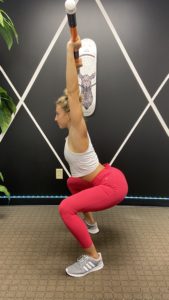




Treatment Techniques
Stretching, proprioceptive neuromuscular facilitation, instrument assisted soft tissue mobilization, and myofascial release are techniques that should be performed on the individuals overactive and tight musculature. Strengthening of the overactive muscles will tend to exacerbate lower cross syndrome.
Strengthening should be performed in the areas of underactive and lengthened musculature. The above techniques should be avoided in these areas as to not exacerbate the syndrome.
- Stretching, proprioceptive neuromuscular facilitation, instrument assisted soft tissue mobilization, myofascial release technique
- Erector spinae
- Multifidus
- Quadratus lumborum
- Latissimus dorsi
- Iliopsoas
- Tensor fasciae latae
- Hamstrings
- Concentric activation, Eccentric activation, Isometric activation
- Rectus abdominis
- Gluteus maximus
- Obliques internus abdominis
- Obliques externus abdominis
- Gluteus medius
- Gluteus minimus
Stretching Exercises for the Overactive Musculature
- Erector spinae
- Multifidus
- Quadratus lumborum
- Latissimus dorsi
- Iliopsoas
- Tensor fasciae latae
- Hamstrings

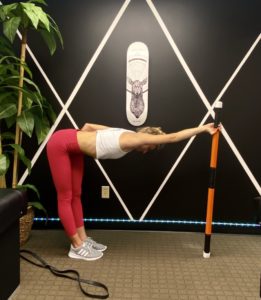

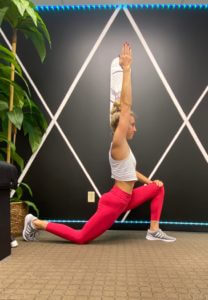

Iliotibial band stretch
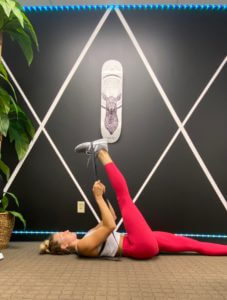
Strengthening Exercises for the Underactive Musculature
- Rectus abdominis
- Gluteus maximus
- Obliques externus abdominis
- Obliques internus abdominis
- Gluteus medius
- Gluteus minimus
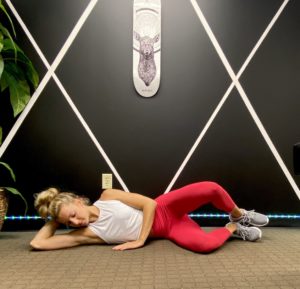



References
https://www.physio-pedia.com/Lower_Crossed_Syndrome
https://blog.nasm.org/lower-crossed-syndrome




